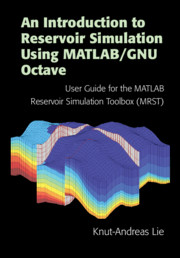 An Introduction to Reservoir Simulation Using MATLAB/GNU Octave
An Introduction to Reservoir Simulation Using MATLAB/GNU Octave Book contents
- Frontmatter
- Contents
- Preface
- 1 Introduction
- Part I Geological Models and Grids
- Part II Single-Phase Flow
- 4 Mathematical Models for Single-Phase Flow
- 5 Incompressible Solvers for Single-Phase Flow
- 6 Consistent Discretizations on Polyhedral Grids
- 7 Compressible Flow and Rapid Prototyping
- Part III Multiphase Flow
- Part IV Reservoir Engineering Workflows
- Appendix The MATLAB Reservoir Simulation Toolbox
- References
- Index
- Index
4 - Mathematical Models for Single-Phase Flow
from Part II - Single-Phase Flow
Published online by Cambridge University Press: 22 July 2019
- Frontmatter
- Contents
- Preface
- 1 Introduction
- Part I Geological Models and Grids
- Part II Single-Phase Flow
- 4 Mathematical Models for Single-Phase Flow
- 5 Incompressible Solvers for Single-Phase Flow
- 6 Consistent Discretizations on Polyhedral Grids
- 7 Compressible Flow and Rapid Prototyping
- Part III Multiphase Flow
- Part IV Reservoir Engineering Workflows
- Appendix The MATLAB Reservoir Simulation Toolbox
- References
- Index
- Index
Summary
The chapter introduces you to mathematical modeling of flow in porous media. We start by explaining Darcy's law, which together with conservation of mass comprises the basic models for single-phase flow. We then discuss various special cases, including incompressible flow, constant compressibility, weakly compressible flow, and ideal gases. We then continue to discuss additional equations required to close the model, including equations of state, boundary and initial conditions. Flow in and out of wells take place on a smaller spatial scale and is typically modeled using special analytical submodels. We outline basic inflow–performance relationships for the special cases of steady and pseudo-steady radial flow, and develop the widely used Peaceman well model. We also introduce streamlines, time-of-flight, and tracer partitions that all can be used to understand flow patterns better. Finally, we introduce basic finite-volume discretizations, including the two-point flux approximation method, and show how such schemes can be implemented very compactly in MATLAB if we introduce abstract, discrete differentiation operators that are agnostic to grid geometry and topology.
Keywords
Information
- Type
- Chapter
- Information
- An Introduction to Reservoir Simulation Using MATLAB/GNU OctaveUser Guide for the MATLAB Reservoir Simulation Toolbox (MRST), pp. 113 - 142Publisher: Cambridge University PressPrint publication year: 2019
- Creative Commons
- This content is Open Access and distributed under the terms of the Creative Commons Attribution licence CC-BY-NC-ND 4.0 https://creativecommons.org/cclicenses/
Accessibility standard: Unknown
Why this information is here
This section outlines the accessibility features of this content - including support for screen readers, full keyboard navigation and high-contrast display options. This may not be relevant for you.Accessibility Information
- 1
- Cited by